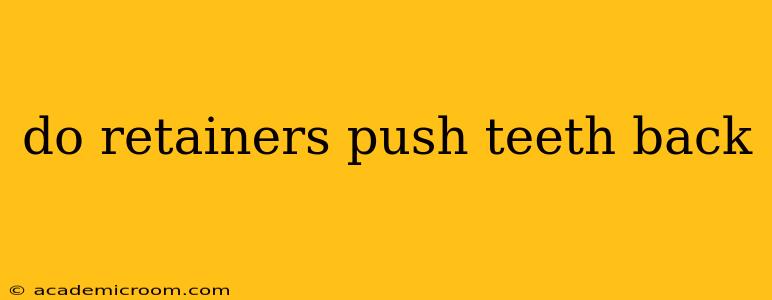Retainers are an essential part of orthodontic treatment, playing a crucial role in maintaining the straight smile achieved through braces or aligners. Many patients wonder about the mechanics of retainers and whether they actively push teeth back into their corrected positions. The answer is nuanced, and understanding how retainers work is key to appreciating their importance in long-term oral health.
How Do Retainers Work?
Retainers don't actively "push" teeth back in the same way braces do. Instead, they gently restrain teeth from shifting back to their original positions. Think of them as a stabilizing force, preventing the natural tendency of teeth to revert to their pre-treatment alignment. The subtle pressure applied by the retainer prevents the bone and soft tissues surrounding the teeth from remodeling and allowing the teeth to drift.
This gentle pressure is crucial because after orthodontic treatment, the supporting bone and gums are still adapting to the new tooth positions. Without a retainer, these tissues can slowly rearrange themselves, leading to a gradual relapse. The retainer helps maintain the newly established equilibrium.
What Types of Retainers Exist?
Different retainer types utilize various mechanisms to achieve stability:
-
Fixed Retainers: These are bonded directly to the back of the teeth, usually the lower incisors. They provide the most stable retention but are permanently cemented in place, requiring professional removal. They exert constant, subtle pressure to maintain alignment.
-
Removable Retainers: These are made from acrylic and wire, often resembling a clear plastic mouthguard or a partial denture. While offering flexibility and removability for cleaning, they exert less constant pressure than fixed retainers. Their effectiveness depends on consistent wear as directed by the orthodontist. They maintain the tooth positions through gentle guidance and resistance to movement.
Do Retainers Move Teeth After Treatment is Finished?
While retainers primarily prevent relapse, they can make minor adjustments. If a tooth has shifted slightly after treatment, the retainer can guide it back to its ideal position. However, this is a minor correction compared to the substantial tooth movement achieved during active orthodontic treatment. Significant tooth movement after treatment necessitates a visit to the orthodontist.
How Long Do I Need to Wear a Retainer?
The duration of retainer wear varies depending on individual factors, such as the severity of the initial misalignment and the patient's age. It is crucial to follow the orthodontist's instructions precisely. Typically, wear time may extend from several months to years, and often long-term retainer use is recommended for life to prevent any relapse. Neglecting retainer use significantly increases the risk of teeth shifting back to their original positions.
What Happens If I Stop Wearing My Retainer?
Stopping retainer use prematurely drastically increases the likelihood of teeth shifting and relapsing. The degree of relapse is variable and depends on individual factors. Some individuals might experience minimal relapse, while others may find their teeth significantly shifting back, necessitating further orthodontic treatment.
Can I Adjust My Retainer Myself?
Never attempt to adjust your retainer yourself. Doing so can damage the retainer and potentially harm your teeth or gums. Any adjustments should only be made by your orthodontist or dentist. If your retainer feels uncomfortable or broken, contact your orthodontist immediately for assistance.
In conclusion, retainers don't push teeth back in a forceful manner but act as a stabilizing force, preventing relapse after orthodontic treatment. Their effectiveness depends on the type of retainer and consistent wear as directed by your orthodontist. Remember, maintaining proper oral hygiene and following your orthodontist's instructions are essential for long-term success.
